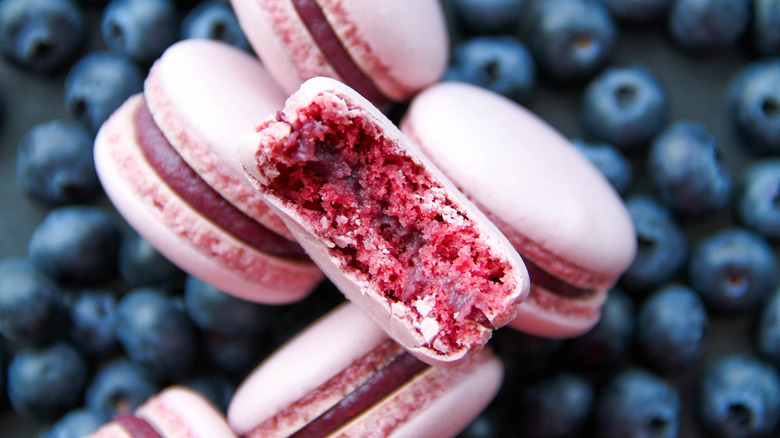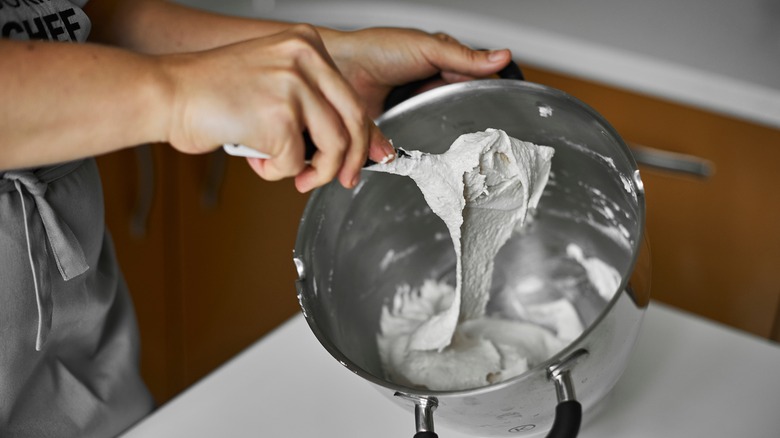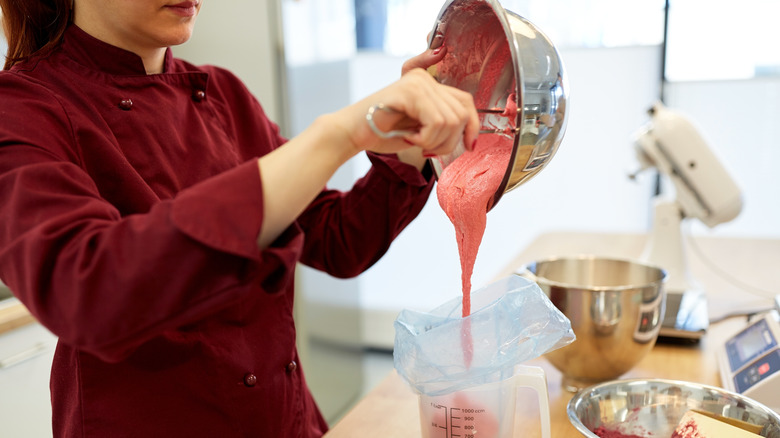The Absolute Best Way To Ensure Your Macarons Are The Perfect Texture
French macarons are tasty, iconic, and famously difficult to make. The process, which takes hours, can be deeply satisfying — or nail-bitingly frustrating.
Macarons can fail in dozens of ways. Sometimes, they just don't rise. Sometimes, they're lumpy on top. Sometimes, they're hollow inside or have uneven and oversized "feet" (the petite trademark ruffles around the macaron shell), or spread out into uneven shapes. The most frustrating part is that several different things could cause each of these issues. However, if you're trying to troubleshoot, macaronage is a good place to start. All of these problems could be caused by improper macaronage technique.
Macaronage refers to the process of folding the dry ingredients into the meringue and deflating the meringue enough to pipe out into smooth, even cookies. It's easy to overmix, resulting in flat, spread-out, uneven cookies with messy feet. It's also easy to undermix, resulting in lumpy, bumpy macarons. Either overmixing or undermixing could leave you with hollow, fragile shells that shatter easily.
Some people regard macaronage as the most important step in making macarons. However, if you're familiar with macarons, you'll know that just about every step is the most important — but it is true that you'll never produce a perfect macaron without mastering macaronage. Like many aspects of macaron baking, it takes trial and error to get right — but reading up on the correct technique will take you a long way.
The right way to mix macaron batter
Macaronage involves folding, a technique used to combine ingredients in a careful, controlled way. Typically, folding is used to avoid knocking the air out of foamy meringues and mousses or to prevent gluten from overdeveloping. With macarons, though, you do want to deflate the meringue — at least, a little bit. There's a fine line between overmixed and undermixed batter, so folding helps you take control of the process and ensure that you don't overdo it.
After whipping the meringue in a large bowl and combining the dry ingredients separately, add roughly a third of the dry ingredients to the meringue. Run a flexible silicone spatula along the side of the bowl, scooping up the ingredients as you go. Once you reach the top of the bowl, pull the spatula towards you, folding the ingredients together and pressing the flat side into the meringue to deflate it. Then, rotate the bowl 90 degrees, circle back around with your spatula, and fold it over again.
Don't be shy: Many bakers are unduly gentile. Use smooth movements and don't work too quickly, but put a little power in each stroke. If you're too gentle with the batter, the meringue won't properly deflate and the ingredients won't blend together.
When to stop
One of the trickiest parts about macaronage is knowing when to stop. Be wary of videos or recipes that tell you exactly how long to take — there will always be factors beyond your control. You might have used a different brand of food coloring or almond flour. You could be baking on a humid day, resulting in thinner, wetter batter. Or maybe, for no apparent reason at all, the macaron gods have thrown you a curveball. Like many aspects of macaron making, you need to learn to pay attention and adapt.
Watching videos that explain macaronage in real-time can be helpful, but don't follow along fold for fold. Instead of focusing on time, focus on the texture of the batter. Once the batter is properly mixed, it should fall off the spatula in smooth, even ribbons. One tried-and-true test: Lift the spatula and draw a figure of eight in the bowl with the trailing ribbons of batter. You should be able to draw in a single motion without the ribbon breaking. Once you've drawn the eight, watch it sink back into the batter. It should be visible for a few moments before slowly smoothing out.
Generally, it's better to undermix than overmix. Overmixing is more likely to cause serious problems, and undermixing is an easier fix. However, it might take some trial and error to get right, either way. Macarons aren't for the faint of heart, but that's part of their beauty — they're so satisfying to perfect.


